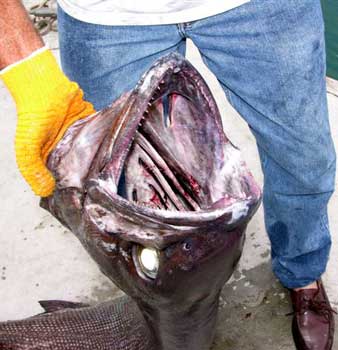Kona Deep Sea Fishing & Sea Monsters Found off Hawaii Island’s Kona Coast
Kona Hawaii is home of some of the world’s BIGGEST pacific blue marlin in the world. Kona fishing charter boat Sea Strike holds numerous world records, including Ray Hawkes’ spectacular 1,166 pound blue marlin on 50-lb test, caught here in Kona, Hawaii.
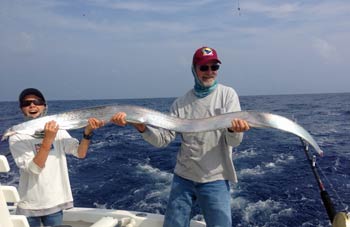
Kona’s deep blue ocean is also home to some interesting creatures. Some are caught on purpose. Some species are caught unintentionally. Some give evidence as to where Hollywood got the ideas for some of their aliens. Following are some of the interesting creatures that Captain Dale Leverone and the Sea Strike have encountered while fishing here in Kona.

The Sea Strike boys find an Unidentified Sea Monster off Kona Coast
On a recent Kona fishing charter trip, the Sea Strike came upon what appeared to be a car bumper floating on the surface. Upon closer inspection, of course, it turned out to be an identified sea creature. “Oar fish” and “cutlass fish” immediately came to mind. Unfortunately, the reason this creature had surfaced in the first place is that something had just bitten its head off, making it difficult, if not impossible, to identify. In fact, the fish was still bleeding. Smart phones are pretty cool devices. 1st mate Jack Leverone took a picture and uploaded it to Facebook. Fishing experts like Jim Rizzuto and Jon Schwartz, who are Facebook friends of Jack’s, saw the photo and called. Since then, the catch went viral, at least momentarily. Jim Rizzuto wrote about it in his weekly newspaper column, the West Hawaii Today. A radio station interviewed Captain Dale Leverone and the story will be featured on a syndicated program across the midwest in February. The catch was featured on MSN.com and Yahoo. Jon Schwartz’s Fishing Blog presented a great article on it.
The diet of a fish, or any creature for that matter, can tell us much about that creature. So, naturally, the Sea Strike boys gutted the sea serpent to see what was there. Found inside was the prehistoric-looking specimen shown at right. Kinda looks like something you may have seen in an alien movie!
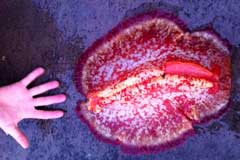
There are more than 3,000 known species of nudibranchs. Sometimes called sea slugs, they are known for their extraordinary colors, striking forms and intricate patterns. Found throughout the world’s oceans, they are most abundant in shallow tropical waters.
Nudibranchs have a very specific diet, so they do not live well outside of their habitat; i.e. aquariums. The nudibranch pictured here was carefully put back in the ocean after being photographed.
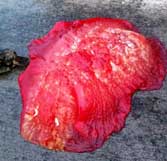
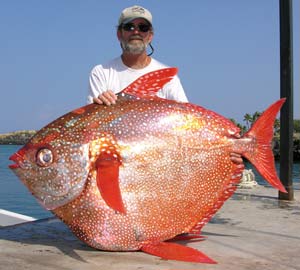
Captain Dale Leverone grew up in Miami and has fished since he was big enough to hold a rod and reel. One day, while in a taxidermist office in Florida, he saw a moonfish, also known as opah, mounted on the wall. At the time, Dale compared it to a jackalope. Since he had been an avid fisherman since childhood, and never heard of, or seen anything like the mounted moonfish, he thought it just a figment of someone’s imagination.
Years later, after arriving on the scene in Hawaii, Dale went into the fish market in Honolulu, and saw the real deal lined up for sale along with the other fish. Captain Dale decided right then that he wanted to catch one. Since opah seemed to only be caught by longliners, there wasn’t much information to be found as to how to catch one on rod and reel.
Eventually, while commercial fishing out of Kona, Dale got a fish on that didn’t feel like the fish he had been catching. He couldn’t believe his eyes when it came up from the depths enough to see that it was an opah. And it was a BIG opah! Unfortunately, Dale and this opah had the company of a shark, coming in for a tasty snack. Fishing alone that day, Dale somehow found the strength to pull this big round fish into the boat fast enough to get it in one piece.
The 135# opah, pictured here, is the current Hawaii State Record for opah caught on rod and reel.
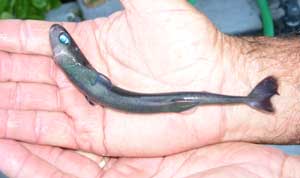
Uncommonly seen up close and personally, the cookie cutter shark leaves its mark on every fish it comes into contact with. The cookie cutter shark is very small on average, just barely larger than the palm of your hand. It latches itself onto a fish, any fish (it’s not picky) and bores a perfectly round cookie shaped hole in the side of its prey, taking a choice morcel of food. This doesn’t seem to harm the fish, but leaves evidence that it has been there.
During a night fishing charter trip for swordfish, Jack Leverone spotted the cookie cutter fish pictured here, and scooped it up with a net. They put it in the bucket, where it stayed alive and well until they returned to the harbor in the morning. A picture was taken and the shark released in good health.
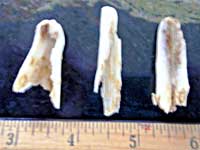
There are many creatures in the sea still waiting to be identified. They leave just enough hints behind to drive fisherman and scientists crazy trying to figure out what the heck is that?
During a Kona fishing charter, the Sea Strike hooked up a nice marlin and the angler got it to the boat with no problem. They agreed to bring the fish in and weigh it. The Sea Strike backed into the dock at Honokohau Harbor, put a tail wrap on the fish and lifted it out to weigh. While the fish was hanging there, Captain Dale noticed some unusual markings on the marlin. Upon closer inspection, he noticed what appeared to be teeth from some kind of whale. He carefully removed the teeth, took a picture, and forwarded it to some knowledgable friends for identification. So far, the teeth, pictured at left, remain an unsolved mystery.
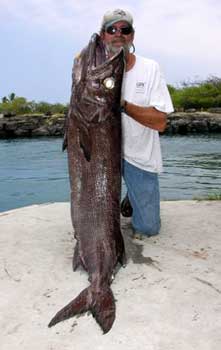
The oilfish is a species of snake mackeral. Locally, oilfish are more commonly picked up by longliners, but occasionally caught on rod and reel as well.
The fish is delicious but very oily. In fact, the flesh has an oil content of approximately 25%, and consists of wax esters, which does not digest like traditional oil. When eaten in large portions, this oil becomes a laxative.
Since oilfish can be substantially cheaper than some other fish species, fish mongers have been known to intentionally mislabel it as butterfish or codfish. Thinking they know what they are eating, cosumers eat large portions of this delicious fish and end up with diahrea. Mislabeling of oil fish has become such a problem that Japan and Italy have imposed an import ban on it and Australia has banned oilfish from being sold as food.
The bottom line is, have a piece of fish for dinner. Enjoy it, but don’t be a pig.
